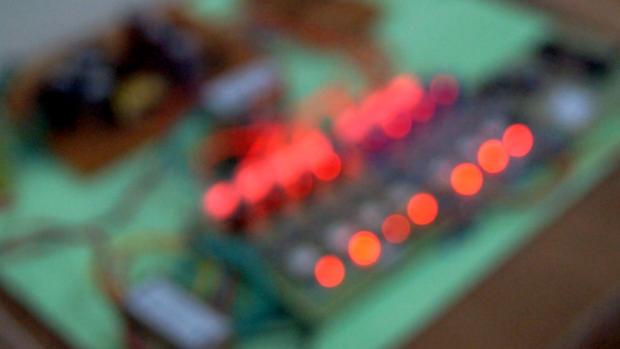
Photo: Siddharth Kankaria / Research Matters
It’s only been just over a century since we began to realise the real world is, in fact, stranger than fiction. Yes, we are talking about quantum mechanics – the strange world of dead and alive Schrödinger’s cats and entangled particles. These quantum properties have deep resonances not just theoretically, but also for practical applications. Studies in quantum information and communication look at how to take advantage of quantum effects to augment our understanding of information and its transference.
Quantum communication promises unbreakable, secure communication, and in a significant step towards making it practical, a team of scientists from the Indian Institute of Science, Bangalore and National Institute of Technology, Surathkal, have proposed a novel integrated optics implementation of a key quantum cryptographic protocol. The research was published in the journal ‘Advances in Photonics of Quantum Computing, Memory, and Communication’.
How do the bizarre seeming quantum effects aid in very real, secure communication? “The answer lies in using quantum cryptography to set up a secure cryptographic key - a string of bits used by a cryptographic algorithm to encode the message or decode it. This key remains private and ensures secure communication. A cryptographic key is the core part of any cryptographic system and its security relies on the security and robustness of the key”, explains Mr. Rohit Ramakrishnan, a Ph.D. scholar at the Department of Electrical Communication Engineering, IISc, and the lead author of the study.
The most successful cryptosystems today make use of the complexity of certain mathematical problems for their security. Take the case of RSA (Rivest-Shamir-Adleman) - the encryption algorithm used for encrypting most communication, including your credit card details during online transactions. It relies on the difficulty of the factoring problem – the task of finding the prime factors of a large number– for the security of its key. This implies that if you have enough computational power, which incidentally, the proposed models of quantum computers possess, you could break into these systems, thus effectively compromising most of the world’s secure systems!
Fortunately, quantum communication itself provides a solution to this conundrum. Imagine you could create a secure key using a protocol, which, by its very design, prevents the knowledge of the key by a third person other than the trusted parties. Wouldn’t that be cryptographic utopia? This is exactly what Quantum Key Distribution (QKD), the most widely studied of quantum cryptographic protocols, offers. Quantum effects are used to set up a secure key, which can then be used to encrypt/decrypt information sent over a usual classical communication channel.
The first and most used QKD protocol that has been verified for 100% secure communication was proposed by Bennett and Brassard in 1984, hence named BB84. In the BB84 protocol, the sender (say Alice) transmits the secret key to the receiver (say Bob), one bit at a time. The quantum effects of ‘superposition’ and the ‘no-cloning theorem’ make sure that a third person cannot ‘read’ the transmitted data without causing disturbances to it, which when detected, enables Alice and Bob to be aware of the eavesdropping and abort the whole operation.
A major limitation of conventional QKD using BB84 is its low data rate. A High Dimensional QKD (HD QKD) was first proposed in a previous study by IISc researchers Mr. Rohit Ramakrishnan and Prof. Srinivas Talabattula. In HD QKD, d bases are used instead of 2, thus allowing d bits of information to be passed per photon pair rather than one.
The successful and fully secure implementation of HD QKD is an open problem in the present times and in their recent publication, the IISc researchers have collaborated with peers from NIT, Surathkal to devise an integrated optics based implementation of both the conventional and HD versions of the BB84 protocol. Like an integrated circuit brings together numerous electronic devices on a single chip, integrated optics devices pack together several optical components performing a common functionality.
The optical circuit for BB84 protocol consists of light sources, polarisers, random number generators, waveguides transmitting encoded photons from the sender to the receiver, and superconducting nanowire single photon detectors (SNSPD) which are naturally sensitive to light polarisation. The data about the private key is encoded into the polarised photons, one bit/photon pair.
In the case of HD QKD, instead of photon pairs, information is encoded in electromagnetic modes, thus allowing a higher data rate. The incoming light from a primary laser is split into four, effectively constructing four sources, each source in turn generating four modes. For each pair of bits to be encoded, the selection of the source is made randomly and depending on the data combination, a particular mode chosen from the source. Thus the data is encoded in the mode and it is transmitted from Alice to Bob via a secure channel. As in the case of the conventional protocol, any attempt at eavesdropping can be detected by taking advantage of the quantum effects.
The researchers are involved in the rigorous theoretical studies of the design before moving on to device fabrication. In fact, they have eyes on an even wider horizon going forward. As Mr. Ramakrishnan puts it, “These devices can be easily integrated into the existing infrastructure for classical communication. These kinds of works are all ultimately progressing towards the realisation of hybrid quantum communication”.






